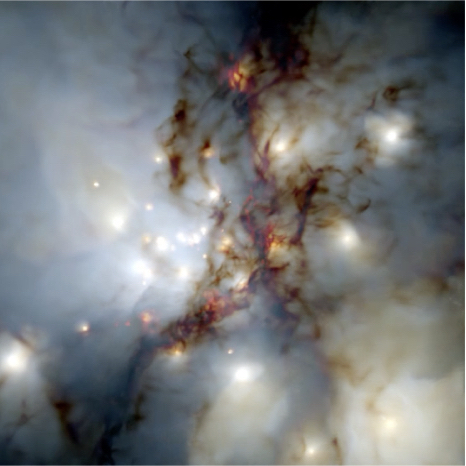Research Activities
Star Formation and ISM Dynamics
Understanding the formation of stars together with their subsequent evolution and identifying the physical processes that govern the dynamics of the interstellar medium (ISM) are central research themes in astronomy and astrophysics. Knowledge of stellar birth is a prerequisite for deeper insights into the assembly of planets and planetary systems and for the search of our own origins. Stars and star clusters are fundamental building blocks of the galaxies we observe. Understanding the formation and evolution of galaxies, their chemical enrichment history, and their observational properties throughout the cosmic ages are key research areas in extragalactic astronomy and cosmology that also depend on a deep understanding of ISM physics.

Dynamical processes in the ISM are the central engine of galaxy evolution, and determine where and at what rate stars form. There are close links between large-scale phenomena, such as spiral arms or tidal perturbations, and the local process of star birth. Conversely, the energy and momentum input from stars is an important driver of ISM dynamics and turbulence. Stellar radiation and winds as well as supernova explosions determine the chemical and thermal state of the ISM, which in turn affects subsequent star formation. The dynamical evolution of the ISM is governed by the complex inter-play between matter and radiation, turbulent motions, magnetic fields, self-gravity, and local variations in the chemical composition.
Shedding light on the fundamental physical processes that control the formation and evolution of stars at different cosmic epochs and identifying and characterizing the various feedback loops that link these together are the focal points of my research activities. Since my appointment as professor for theoretical astrophysics at Heidelberg University in 2006, I have built up a very active and productive research team in numerical astrophysics with a strong focus on star formation and ISM physics at present days as well as in the early universe. The group plays a leading international role in developing a theory of star formation based on the interplay between interstellar turbulence and gravity. This approach is remarkably successful, has high predictive power, and has become the accepted paradigm for the birth of stars in the complex multi-phase interstellar medium. We are extending this theory on large scales to account for the global star-formation relations in disk galaxies, and we are exploring in detail the nature of stellar birth in the early universe and study the transition from primordial star formation to the mode observed today.
Recent results indicate that our view of primordial star formation indeed needs substantial revision. Our group has shown that fragmentation is a widespread phenomenon in early star formation, and so many if not most primordial stars had intermediate to low masses. Stellar birth at very high redshift is not as simple as previously thought, but instead faces the same complexities as present-day star formation. This has important implications for many fields of modern astronomy and astrophysics. It requires us to rethink our picture of cosmic reionization and early galaxy formation, and to reconsider our understanding of the chemical enrichment history of the universe.
Scientific Gloals
It is my long-term research goal to address and answer the following key questions:
- Star Formation: What are the physical processes that govern the birth of stars and their planetary systems in our Milky Way and in distant galaxies throughout the cosmic ages? What can we learn from that about our cosmic origin?
- Multi-Phase ISM: How do the different phases of the ISM evolve and interact with each other to form new stars, and how does this depend on environmental parameters?
- Feedback: What triggers and regulates star formation on different scales? How does feedback from massive stars influence the dynamical and chemical evolution of our Galaxy?
- Local Galactic Environment: What physical processes shaped our Galactic neighborhood during the past 20 or so million years? Specifically, how unique is the Local Bubble and how is it related to the large-scale structure of the Milky Way and to other nearby features?
- Turbulence: What are the fundamental processes that control turbulent astrophysical flows, and what is the best approach for their mathematical description?
To go beyond the current state-of-the-art requires the accurate and simultaneous treatment of very diverse physical processes over many different scales. This lies at the very forefront of computational astrophysics. The forma)on of stars and the dynamics of the ISM can only be understood by considering self-gravity, turbulence, magnetic fields, the coupling between matter and radiation, chemical reactions, stellar feedback, cosmic rays, as well as the galactic environment consistently and simultaneously. Only very recently have researchers begun to truly face this complexity.
Selected Research Highlights
For a discussion of selected research highlights follow this LINK.
